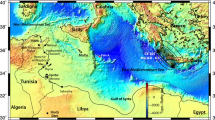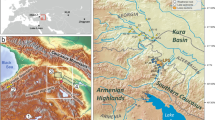Abstract
DURING the 23rd expedition of RV Academic Kurchatov, 27 cores of bottom sediments were taken from the Rybachiy Peninsula–Franz Josef Land profile1. The lithological data and the record of pollen analysis revealed the Lower Cretaceous deposits in the basement of two cores in the northern part of the sea. They are overlain by ‘ancient clays’ (tills)—dark-grey, grey and brown-grey loams and clays of average (1.6–1.8 g cm−3) and high (2.0–2.2 g cm−3) density. These clays are shown here to have commenced deposition 3.5 Myr ago, proving that the Barents Ice Sheet (BIS) existed in the late Pliocene. This indicates when glaciation in the mid-latitude began, and why alternation of glacial and interglacial periods occurred.
This is a preview of subscription content, access via your institution
Access options
Subscribe to this journal
Receive 51 print issues and online access
$199.00 per year
only $3.90 per issue
Buy this article
- Purchase on Springer Link
- Instant access to full article PDF
Prices may be subject to local taxes which are calculated during checkout
Similar content being viewed by others
References
Blazhchishin, A. I. & Linkova, T. I. Dokl. Akad. Nauk SSSR 236, 696 (1977).
Stupavsky, M., Symons, D. T. A. & Gravenor, C. P. Geol. Soc. Am. Bull. 85, 141 (1974).
Kvasov, D. D. Bull. Moskow Soc. Natur. Geol. ser. no. 6, 99 (1966).
Kvasov, D. D., Ananova, E. N., Borisov, A. A. & Dibner, V. D. Vestnik Leningradskogo universiteta No. 6, 142 (1969).
Wensink, H. Geol. Rundschau. 54, 364 (1965).
Herman, Y. in Marine Geology and Oceanology of the Arctic Seas (ed. Herman, Y.) 283–348 (Springer, New York, 1974).
Berggren, W. A. Init. Rep. DSDP 12, 953–963 (1972).
Wetherald, R. T. & Manabe, S. J. J. atmos. Sci. 32, 2044 (1975).
Grichiuk, V. P. Pollen Spores 13, 101 (1971).
Frenzel, B. Climatic Fluctuations of the Ice Age (Case Western Reserve Univ., Cleveland, 1973).
Nehring, A. Ueber Tundren und Steppen der Jetzt- und Vorzeit mit besonderer Berücksichtigung ihrer Fauna (Dümmler, Berlin, 1890).
Vangengejm, E. A. Biul. perygl. Sec. 3, N 24, 81 (1975).
Soergel, W. Lösse, Eiszeiten und paläolitische Kulturen (Fischer, Jena, 1919).
Kvasov, D. D. in Paleolimnology of Lake Biwa and the Japanese Pleistocene (ed, Horie, S.) 3, 420–428 (Kyoto Univ., 1975).
Kvasov, D. D. Ann. Acad. Sci. Fenn. A III, 1978).
Kvasov, D. D. Eiszetalter Gegenw. 22, 178 (1971).
Kvasov, D. D. Quat. Res. (in the press).
Weertman, J. J. Glaciol. 13, 3 (1974).
Lavrov, A. S. in The Structure and Dynamics of the Last Ice Sheet of Europe (ed. Chebotareva, N. S.) 83–100 (Vauka, Moscow, 1977).
Hughes, T., Denton, G. H. & Grosswald, M. G. Nature 266, 596 (1977).
Astachov, V. I. Dokl. Akad. Nauk SSSR 231, 1178 (1976).
Kvasov, D. D. in 23rd Int. Geogr. Congr. Section 1, 304–307 (Vneshtorgizdat, Moscow, 1976).
Author information
Authors and Affiliations
Rights and permissions
About this article
Cite this article
KVASOV, D., BLAZHCHISHIN, A. The key to sources of the Pliocene and Pleistocene glaciation is at the bottom of the Barents Sea. Nature 273, 138–140 (1978). https://doi.org/10.1038/273138a0
Received:
Accepted:
Issue Date:
DOI: https://doi.org/10.1038/273138a0
This article is cited by
-
Neogene explosive volcanicity, temperature and glaciation
Nature (1979)
-
Glaciation in Bolivia before 3.27 Myr
Nature (1979)
Comments
By submitting a comment you agree to abide by our Terms and Community Guidelines. If you find something abusive or that does not comply with our terms or guidelines please flag it as inappropriate.



